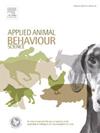法属波利尼西亚自由放养的瓶鼻海豚(Tursiops truncatus)与潜水员互动时胆量的个体差异
IF 2.2
2区 农林科学
Q1 AGRICULTURE, DAIRY & ANIMAL SCIENCE
引用次数: 0
摘要
众所周知,海洋野生动物旅游会在多个空间和时间尺度上影响目标物种,从短期行为反应到相对丰度和栖息地使用模式的变化。然而,尽管有越来越多的种群、群落和群体层面的研究,但其中数量有限的研究侧重于个体对野生动物旅游的反应,尤其是对自由活动的鲸目动物。2018 年至 2020 年间,我们在法属波利尼西亚兰吉罗亚环礁调查了 20 头无家养瓶鼻海豚(Tursiops truncatus)对休闲潜水员的行为反应,以了解这些至少有一年时间反复接触潜水旅游的个体是否表现出 "害羞-大胆 "轴上的性情特征。我们还考虑了胆量与性别、年龄和旅游地忠诚度之间的潜在差异。研究记录了海豚胆量的个体差异。海豚的胆量与性别和对旅游景点的忠诚度没有关系,但年龄对海豚的胆量有显著影响,未成年海豚比成年海豚更大胆。胆大妄为的极端情况是,四条海豚容忍了与潜水员的反复肢体互动。在兰吉若阿,潜水旅游促进了与海豚的反复侵入性互动,这可能使大胆的海豚个体特别容易受到与人类活动相关的附带威胁。因此,考虑海豚对旅游业行为反应的个体差异,以实施最佳的旅游业管理措施至关重要。我们在讨论中提出了一些建议,以帮助最大限度地降低海豚和人类因反复亲密互动而面临的风险。本文章由计算机程序翻译,如有差异,请以英文原文为准。
Individual variation of boldness in free-ranging bottlenose dolphins (Tursiops truncatus) interacting with scuba divers in French Polynesia
Marine wildlife tourism is known to affect target species across multiple spatial and temporal scales, from short-term behavioral responses to changes in relative abundance and habitat use patterns. However, despite a growing number of population-, community-, and group-level studies, a limited number of them have focused their research on individual responses to wildlife tourism, particularly on free-ranging cetaceans. Between 2018 and 2020, we investigated the behavioral responses of 20 non-provisioned bottlenose dolphins (Tursiops truncatus) to recreational scuba divers in Rangiroa Atoll, French Polynesia, to understand whether these individuals that had been repeatedly exposed to scuba diving tourism on at least one year exhibited temperament traits along the ‘shyness-boldness’ axis. We also considered potential variation in boldness in relation to sex, age, and tourist-site fidelity. The study documented individual differences in the dolphins’ boldness. There was no variation in boldness according to sex and tourist-site fidelity, but age significantly influenced the dolphins’ boldness with immature dolphins being bolder than mature individuals. The more extreme case of boldness involved four dolphins that tolerated repeated physical interactions with scuba divers. In Rangiroa, scuba diving tourism promotes repeated intrusive interactions with dolphins that might make bold individuals particularly vulnerable to collateral threats associated with human activities. It is therefore crucial to consider individual variation in the dolphins’ behavioral responses to tourism to implement optimal tourism management measures. We suggest in the discussion recommendations to help minimize the risks for both the dolphins and humans associated with repeated close interactions.
求助全文
通过发布文献求助,成功后即可免费获取论文全文。
去求助
来源期刊

Applied Animal Behaviour Science
农林科学-行为科学
CiteScore
4.40
自引率
21.70%
发文量
191
审稿时长
18.1 weeks
期刊介绍:
This journal publishes relevant information on the behaviour of domesticated and utilized animals.
Topics covered include:
-Behaviour of farm, zoo and laboratory animals in relation to animal management and welfare
-Behaviour of companion animals in relation to behavioural problems, for example, in relation to the training of dogs for different purposes, in relation to behavioural problems
-Studies of the behaviour of wild animals when these studies are relevant from an applied perspective, for example in relation to wildlife management, pest management or nature conservation
-Methodological studies within relevant fields
The principal subjects are farm, companion and laboratory animals, including, of course, poultry. The journal also deals with the following animal subjects:
-Those involved in any farming system, e.g. deer, rabbits and fur-bearing animals
-Those in ANY form of confinement, e.g. zoos, safari parks and other forms of display
-Feral animals, and any animal species which impinge on farming operations, e.g. as causes of loss or damage
-Species used for hunting, recreation etc. may also be considered as acceptable subjects in some instances
-Laboratory animals, if the material relates to their behavioural requirements
 求助内容:
求助内容: 应助结果提醒方式:
应助结果提醒方式:


